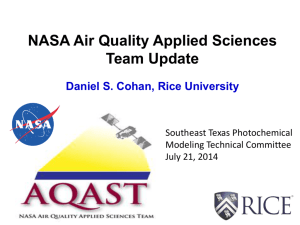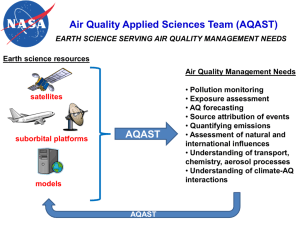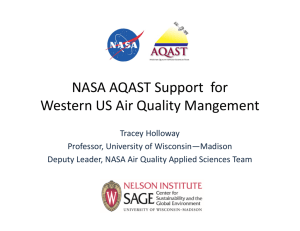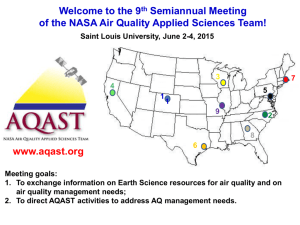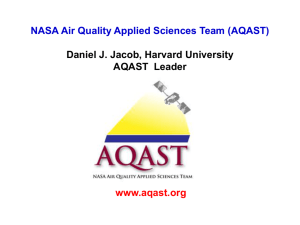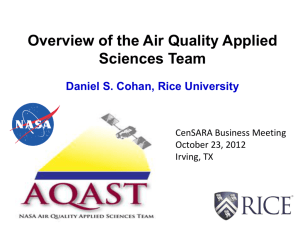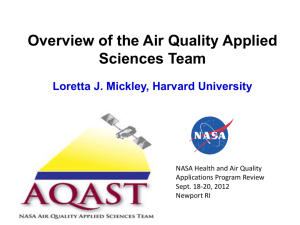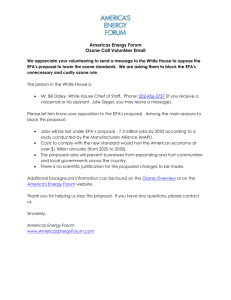PPT
advertisement
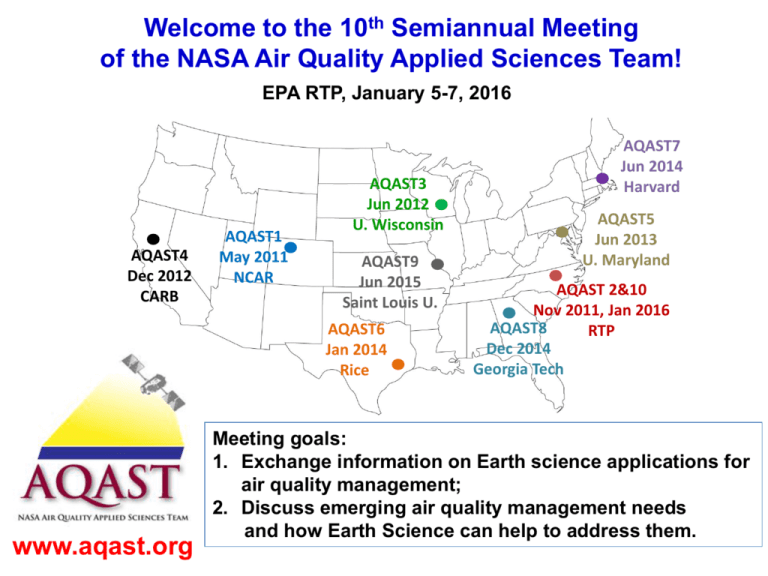
Welcome to the 10th Semiannual Meeting of the NASA Air Quality Applied Sciences Team! EPA RTP, January 5-7, 2016 AQAST4 Dec 2012 CARB AQAST1 May 2011 NCAR AQAST3 Jun 2012 U. Wisconsin AQAST9 Jun 2015 Saint Louis U. AQAST6 Jan 2014 Rice www.aqast.org AQAST7 Jun 2014 Harvard AQAST5 Jun 2013 U. Maryland AQAST 2&10 Nov 2011, Jan 2016 AQAST8 RTP Dec 2014 Georgia Tech Meeting goals: 1. Exchange information on Earth science applications for air quality management; 2. Discuss emerging air quality management needs and how Earth Science can help to address them. Quick overview of agenda Day 1: Tuesday January 5 - NASA and EPA managers’ perspectives - Air quality science and applications sessions - Poster session (3-5 pm) Day 2: Wednesday January 6 - Air quality managers’ session and discussion panel - Group photo (11:45 am) - Air quality science and applications sessions Day 3: Thursday January 7 - Tiger Team breakouts - AQAST action items 19 team members appointed in May 2011 for 5-year terms satellites suborbital platforms AQAST models Earth Science resources AQAST Pollution monitoring Exposure assessment AQ forecasting Source attribution Quantifying emissions External influences AQ processes Climate interactions US air quality management 3 AQAST members • Daniel Jacob (leader), Loretta Mickley (Harvard) • Tracey Holloway (deputy leader), Steve Ackerman (U. Wisconsin); Bart Sponseller (Wisconsin DNR) • Greg Carmichael (U. Iowa) • Dan Cohan (Rice U.) • Russ Dickerson (U. Maryland) • Bryan Duncan, Yasuko Yoshida, Melanie Follette-Cook (NASA/GSFC); Jennifer Olson (NASA/LaRC) • David Edwards (NCAR) • Arlene Fiore (Columbia Univ.); Meiyun Lin (Princeton) • Jack Fishman, Ben de Foy (Saint Louis U.) • Daven Henze, Jana Milford (U. Colorado) • Edward Hyer, Jeff Reid, Doug Westphal, Kim Richardson (NRL) • Pius Lee, Tianfeng Chai (NOAA/NESDIS) • Yang Liu, Matthew Strickland (Emory U.), Bin Yu (UC Berkeley) • Richard McNider, Arastoo Biazar (U. Alabama – Huntsville) • Brad Pierce (NOAA/NESDIS) • Ted Russell, Yongtao Hu, Talat Odman (Georgia Tech); Lorraine Remer (NASA/GSFC) • David Streets (Argonne) • Jim Szykman (EPA/ORD/NERL) • Anne Thompson, William Ryan, Suellen Haupt (Penn State4U.) What makes AQAST unique? Broad mandate to serve the evolving needs of US air quality management o AQAST is self-organizing, defines its own projects in consultation with AQ managers o Focus is on quick response to AQ agencies at national/regional/state/local levels o All projects involve partnerships with AQ managers, application outcomes o Multi-member Tiger Teams tackle problems requiring coordinated activity o Communication with AQ managers is emphasized through multiple channels o Outreach to public is an additional important component Quick, collaborative, flexible, responsive to the needs of the AQ community http://www.aqast.org/ http://www.aqast-media.org/ Current AQAST Tiger Teams Selected through on-line polling of AQ management community (62 responses) and subsequent review by AQ managers’ panel (Pat Dolwick, EPA; Tom Moore, WRAP; Susan Wierman, MARAMA; Paul Miller, NESCAUM) Source contributions to O3 and PM2.5 pollution episodes across Eastern US (Holloway, Fiore) LADCO, MARAMA, OTC, Connecticut, Maine, Maryland, Missouri, New Hampshire, New York, Texas, Maricopa Satellite NO2 columns, NOx emissions, and air quality in North America (Streets) EPA, LADCO, Maryland Satellite signatures of emissions associated with US oil & gas extraction (Thompson) BLM, EPA Region 8, MARAMA, CenSARA, Colorado, Maryland, Oklahoma Web-enabled tools for AQ management decision support (Szykman, Spak) EPA, Iowa, San Joaquin Dynamic inputs of Natural Conditions for Air Quality Models (Cohan) EPA, California, Texas Air quality reanalysis (Carmichael) EPA, CDC, California, Georgia, Maryland, Virginia, South Coast Evaluation of AQAST’s impact (Milford) EPA, WRAP, San Joaquin Air quality agency partners on AQAST projects EPA2 EPA8 EPA5 5 National 9 Regional 16 State 6 Local EPA, NOAA, CDC NPS, BLM Air quality agencies participating in AQAST meetings EPA2 EPA8 EPA5 EPA9 EPA4 EPA, NOAA, CDC, NPS, BLM, USDA 6 National 12 Regional 27 State 7 Local Number of publications Publications acknowledging AQAST funding 50 45 40 35 30 25 20 15 10 5 0 Multiple PIs Multiple AQAST PIs Single AQAST PI Single AQAST PI 2011 2012 2013 2014 2015 30% of 2014-2015 AQAST publications were written as collaboration between PIs Feb. 2014 AQAST special issue of Environmental Manager 13 contributing AQAST PIs • • • • • • • NASA AQAST (Jacob et al.) Integrating satellite data into air quality management: experience from Colorado (Witman and Holloway) Monitoring PM2.5 for health: past, present, and future directions (Liu) Air quality forecasting (Hu et al.) Interactions between climate change and US air quality (Mickley et al.) Using satellite observations to measure power plant emissions and their trends (Streets et al.) Detecting and attributing episodic high background ozone events (Fiore et al.) AQAST primer on use of satellite data to quantify emissions Tiger Team involving 10 AQAST PIs Highly Cited Paper (top 1% of Earth science 2013 publications) 11 AQAST primer on use of satellite data for AQ applications Tiger Team involving 10 AQAST PIs Single most downloaded Energy & Earth Science article since January 2014 12 Many facets of AQAST support of air quality management software tools working on SIPs Interpretation of events organization of conferences training workshops AIRS ozone exceptional event designations NO2 trends lenticular AQAST outreach Twitter: @NASA_AQAST AQAST media center ozone gardens News conferences Continuity of AQ measurements from space is now ensured by operational satellites GOME-2 and IASI (Europe), OMPS and VIIRS (US) Summer 2013 Formaldehyde 09:30 LT GOME2-B 13:30 LT OMPS TROPOMI to be launched in 2016: daily NO2, formaldehyde, ozone, CO, methane at 7x7 km2 resolution Current methane observations from GOSAT Next frontier: NASA TEMPO geostationary satellite data 2018-2021 launch; PI Kelly Chance (Harvard-Smithsonian) • • • • Hourly observations at 2x2 km2 resolution Aerosol optical depth, ozone, NO2, formaldehyde, SO2… First measurements of ozone in boundary layer (visible Chappuis bands) Part of a geostationary constellation with concurrent satellites observing East Asia and Europe AQAST legacy and future • AQAST has been tremendously successful • It has developed broad relationships with AQ agencies at all levels • It has transformed the use of Earth science products for AQ applications • It has elevated the visibility of AQ research and applications at NASA • AQAST work must continue in the future • Maintain the network of partnerships developed with AQ community • Respond to emerging AQ issues • Exploit new opportunities offered by TROPOMI, TEMPO New H-AQAST team now being solicited by NASA ASP for Juy 2016 start; AQAST will live on!

